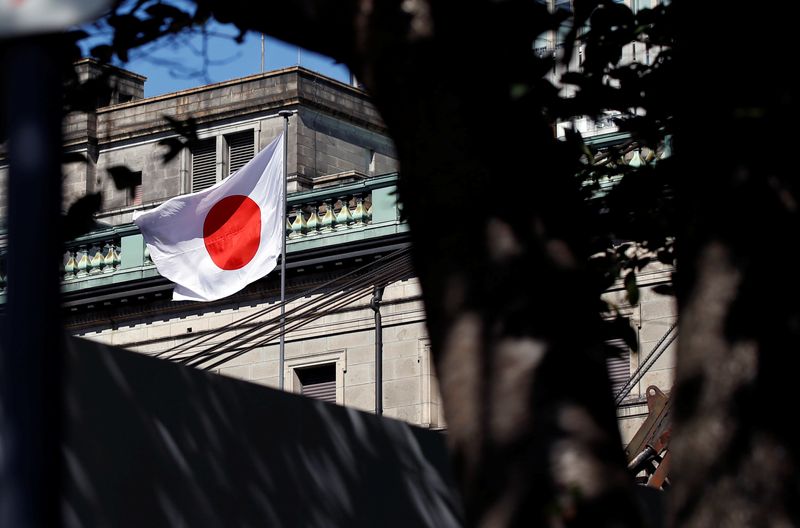By Leika Kihara
TOKYO (Reuters) - The Bank of Japan shocked markets on Tuesday with a surprise tweak to its bond yield control that allows long-term interest rates to rise more, a move aimed at easing some of the costs of prolonged monetary stimulus.
Shares tanked, while the yen and bond yields spiked following the decision, which caught off-guard investors who had expected the BOJ to make no changes to its yield curve control (YCC) until Governor Haruhiko Kuroda steps down in April.
In a move explained as seeking to breathe life back into a dormant bond market, the BOJ decided to allow the 10-year bond yield to move 50 basis points either side of its 0% target, wider than the previous 25 basis point band.
But the central bank kept its yield target unchanged and said it will sharply increase bond buying, a sign the move was a fine-tuning of existing ultra-loose monetary policy rather than a withdrawal of stimulus.
Kuroda said the move was aimed at ironing out distortions in the shape of the yield curve and ensuring the benefits of the bank's stimulus programme are directed to markets and companies.
"Today's step is aimed at improving market functions, thereby helping enhance the effect of our monetary easing. It's therefore not an interest rate hike," Kuroda told a news conference.
"This change will enhance the sustainability of our monetary policy framework. It's absolutely not a review that will lead to an abandonment of YCC or an exit from easy policy."
GRAPHIC: BOJ widens band around its yield cap (https://www.reuters.com/graphics/JAPAN-ECONOMY/BOJ/lgvdkkamdpo/chart.png)
As widely expected, the BOJ kept unchanged its YCC targets, set at -0.1% for short-term interest rates and around zero for the 10-year bond yield, at a two-day policy meeting that ended on Tuesday.
The BOJ also said it would increase monthly purchases of Japanese government bonds (JGBs) to 9 trillion yen ($67.5 billion) per month from the previous 7.3 trillion yen.
The benchmark Nikkei share average slumped 2.5% after the decision, while the dollar fell as much as 3.1% to a four-month low of 132.68 yen. The 10-year JGB yield briefly spiked to 0.460%, close to the BOJ's newly set implicit cap and the highest level since 2015.
NOT CONVINCED
Kuroda stressed the move was not a prelude to a bigger tweak to YCC and an eventual exit from ultra-easy policy, sticking to his view that Japan's fragile economy still needed support.
But some market players were unconvinced.
"Maybe this is a baby step to test out the strategy and see what the market reaction is, and how much it's reacting," said Bart Wakabayashi, branch manager at State Street (NYSE:STT) in Tokyo. "I think we're seeing the first toe in the water."
Already, markets are guessing what the BOJ's next move could be as Kuroda's term draws to an end and with inflation expected to remain above its 2% target well into next year.
"They've widened the band, and I guess that came earlier than expected. It raises questions as to whether this is a precursor of more to come, in terms of policy normalisation," said Moh Siong Sim, currency strategist at Bank of Singapore.
Shares of Japan's banking sector bucked the broader market downtrend to rise 5.12%, highlighting investors' expectations that years of ultra-low rates that squeezed earnings from loans and deposits could be ending.
The abrupt decision to widen the yield band, rather than wait for the right timing to undertake bolder tweaks to YCC, underscores the challenges the BOJ faces in addressing the rising cost of prolonged easing.
It also reflects the broader challenge central banks have faced globally in trying to effectively communicate a shift to less accommodative policy after an extended period of unorthodox monetary settings.
"The way the BOJ moved abruptly without communication with markets makes the BOJ's course of action unpredictable, making it almost impossible to read its mind," said Atushi Takeda, chief economist at Itochu Economic Research. "Whoever becomes next BOJ governor must strive to make monetary policy more transparent and predictable."
The BOJ's ultra-low rate policy and its relentless bond buying to defend its yield cap have drawn increasing public criticism for distorting the yield curve, draining market liquidity and fuelling an unwelcome yen plunge that inflated the cost of raw material imports.
Much of that public anger has centred on Kuroda, who was handpicked by former prime minister Shinzo Abe as BOJ governor a decade ago to rev up sluggish consumer demand with massive monetary stimulus.
In a rare acknowledgement of the drawbacks of his policy, Kuroda said the decision to widen the yield band now came from surveys showing a sharp deterioration in bond market functions.
He also said the BOJ must look not just at downside but upside risks to growth and inflation, signalling that there was scope for a withdrawal of stimulus next year if economic conditions allow.
"It's premature to debate specifics on changing the monetary policy framework or an exit from easy policy," Kuroda said.
"When achievement of our target comes into sight, the BOJ's policy board will hold discussions on an exit strategy and offer communication to markets."
($1 = 133.3200 yen)
